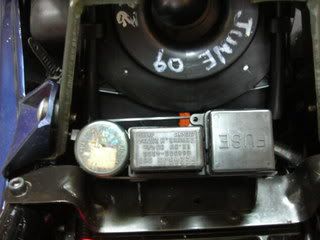OK this fix will only work if you still have an old school filament bulb in either the front or back signals. In my case, I installed LED rear turn signals when I chopped my shovel which caused the signals to flash really fast. After installing the electronic flasher I was happy that it cured the fast flash problem for now, but testing the unit with LEDs in the front and rear signals yielded a non-working (no flashing) unit. I'm going to order a true electronic flasher unit and install it prior to installing the LED boards in my front lenses. The following write up will remain the same, it will just be a matter of what flasher unit you choose to install.
What you need:
A two terminal electronic flasher unit (see note above concerning choosing a flasher)
2 female .250" blade connectors sized for wire you use for extensions - in my case #18 AWG
Couple of short pieces of heat shrink tubing
Soldering iron and solder (if you choose to solder the wire extensions)
Tiny flat blade screwdriver to remove OEM spade terminal in relay socket
Wire stripper / terminal crimper
Some 18 AWG or 20 AWG for wire extensions

1. Pop your seat off, unbolt the fuse box /relay bracket and remove the fuse box / relay assembly from the bracket. (removal not nessacarily needed but makes life easier) Remove the flasher / sidestand relay

2. OK, you want the light blue and orange with green trace wires that go into the relay socket.

Push the wires up into the socket and using a very small flat object or tiny screwdriver release the retaining tab by sliding the screwdriver down the flat side of the terminal in the socket from the top, were the relay would plug in. Bad pic but anyway.

While holding screwdriver in place, pull the wire out from the back.

Do both wires.

3. Wires are a little short, so cut terminals off and splice a couple of short extensions on and install .250 " female terminals on ends. I chose 90* terminal, but straight ones would have worked even better.


4. Slide terminals on blades of flasher unit. The flasher I picked up was marked for power supply and load (light side), so light blue goes to load terminal and orange/ green goes to power supply. (Which you can't see in pics because both my wire extensions are black - all I had around)
5. Position flasher unit along side of the side stand relay and zip tie in place.

A LED flasher would be best to install, then you could run LED signals all around and still have the flash functionality.
What you need:
A two terminal electronic flasher unit (see note above concerning choosing a flasher)
2 female .250" blade connectors sized for wire you use for extensions - in my case #18 AWG
Couple of short pieces of heat shrink tubing
Soldering iron and solder (if you choose to solder the wire extensions)
Tiny flat blade screwdriver to remove OEM spade terminal in relay socket
Wire stripper / terminal crimper
Some 18 AWG or 20 AWG for wire extensions

1. Pop your seat off, unbolt the fuse box /relay bracket and remove the fuse box / relay assembly from the bracket. (removal not nessacarily needed but makes life easier) Remove the flasher / sidestand relay

2. OK, you want the light blue and orange with green trace wires that go into the relay socket.

Push the wires up into the socket and using a very small flat object or tiny screwdriver release the retaining tab by sliding the screwdriver down the flat side of the terminal in the socket from the top, were the relay would plug in. Bad pic but anyway.

While holding screwdriver in place, pull the wire out from the back.

Do both wires.

3. Wires are a little short, so cut terminals off and splice a couple of short extensions on and install .250 " female terminals on ends. I chose 90* terminal, but straight ones would have worked even better.


4. Slide terminals on blades of flasher unit. The flasher I picked up was marked for power supply and load (light side), so light blue goes to load terminal and orange/ green goes to power supply. (Which you can't see in pics because both my wire extensions are black - all I had around)
5. Position flasher unit along side of the side stand relay and zip tie in place.

A LED flasher would be best to install, then you could run LED signals all around and still have the flash functionality.
















Comment